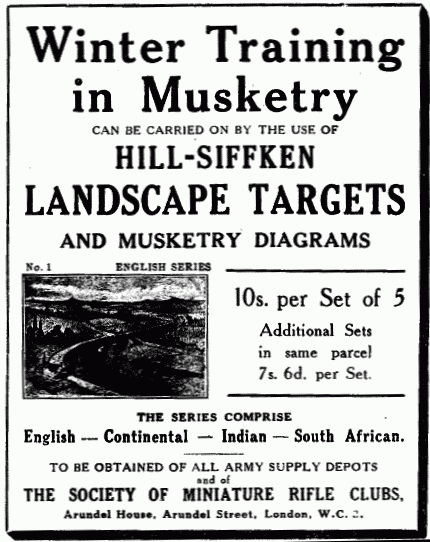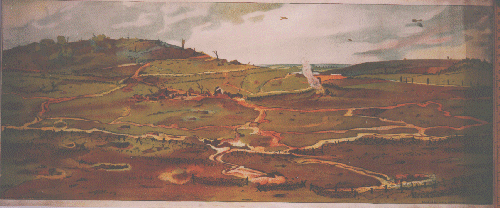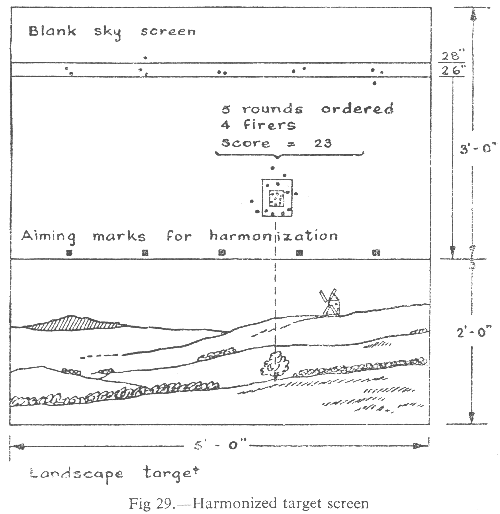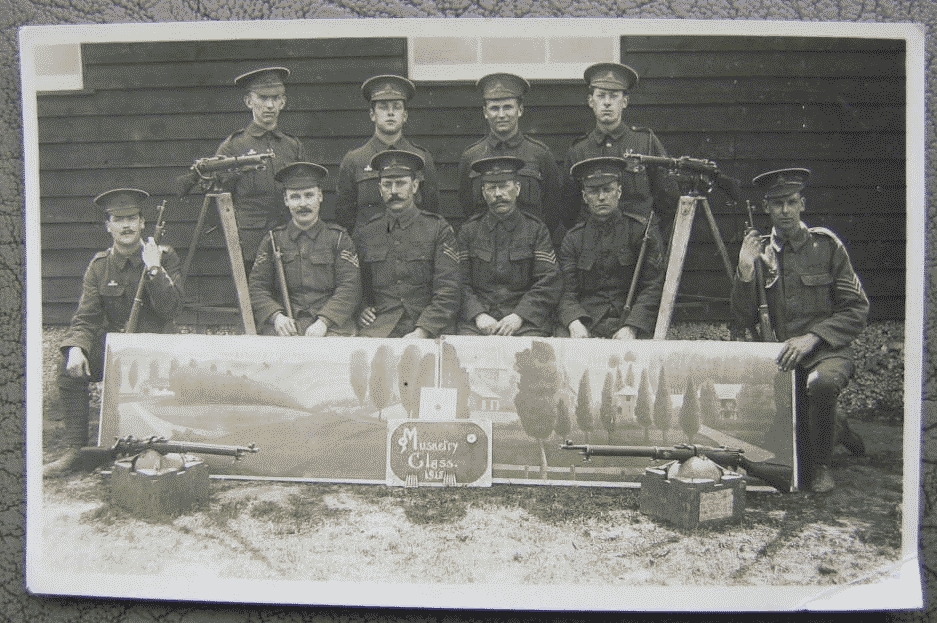
SEE ALSO: ..TRAINING & SOLANO TARGETS.........SWIFT TRAINING RIFLE TARGETS.........NOVELTY TARGETS.........LEAGUES TARGETRY......... SMRC & NSRA TARGETRY
for fire direction training:
TARGETS such as this, from a large series, were used both to train the individual soldier in field firing,
and to train the N.C.O. or Officer in fire direction.
Below: a 1916 advertisement for the Hill-Siffken Company's products.

Below is a First world War representative Landscape target
by the Hill-Siffken Company dating from between the wars.
Actual sizes of these target scenes are of the order of five feet wide and vary in height,
between the wars, from 25 inches ( WWI) to 30 and 40 inches post (WWII).

The system then operated is, in modified form, still in use.

Early instructions for harmonized firing can be read
below in an extract from the Infantry Training Manual
(submitted by Roy with our thanks)
" SECTION 9.--FIRING WITH HARMONIZED SIGHTS
Aim
1. To give NCOs practice at giving fire control orders, and men at recognizing targets and shooting at them.Stores
2. Rifles, ammunition, landscape target and screen (Flg 29), small replica of landscape target, binoculars, measuring rod 27 inches long, plumb line consisting of a small weight on a piece of string, scoring rectangles 5 inches by 4 inches and 2 inches by 2 inches, patching materials, blackboard and chalk.
Preparation of the rifles
3. Set the sights for harmonized firing (1,400 for No. 2 Rifles, "H" for No. 8 Rifles), and get skilled shots to fire at the aiming marks at the bottom of the sky screen, and go on altering the sights until they put at least two consecutive shots between the horizontal lines at the top; record the rifle numbers and sight settings on a board to be kept in the range, and do not allow any further adjustment of the sights.
4. Harmonized firing is also possible with No. 4, but not No. 5, Rifles or, a 25 yards range; set the sights at 1,300; have your horizontal lines 23 and 25 inches above the bottom of the aiming mark; and use a measuring rod 24 inches long.
5. The reason for harmonized firing is to avoid damage to landscape targets.
Conduct of a shoot
6. Put the section in position, and get the section commander to organize an arc of fire. With a pin, point out the target to the section commander on the replica; he goes back to the section, and gives a fire control order; the section fires (two or three rounds are enough). Cover the sky screen, and get each man to show you where he aimed.
7. To assess fire effect, hold the measuring rod vertically (check with the plumb line), with the bottom on the target. Make a mark on the screen at the top of the rod, and put the centre of the scoring rectangle on the mark; shots in the small rectangle count two, in the large rectangle one."
___________________
Below is a series of five Hill Siffken Landscapes of the Continental Series
Below is a photograph of a Musketry Class of 1915 taken with a Landscape target utilising the "Continental" Series sections nos. 9 & 10, probably at the completion of a course. No.9 was representative of a 'actual country in France' and no.10 of the same in Belgium. The sections were designed to be approximately linked side by side in any order, by virtue of the half pine-tree printed at each side of each target, as shown in use in the photograph below.
The rifle in use is the Charger Loading Magazine Lee-Enfield ( C.L.M.L.E.) which had, by 1915, been technically superseded by the rifle Short, Magazine, Lee-Enfield ( S.M.L.E. ) introduced in 1903; but wartime demand for the new rifle far outstripped supply in the early years, and the " Long-Lee", as the older rifle became fondly known, was still very much in play, particularly for training purposes.
Two of the rifles can be seen fitted to "Aiming Stands" used to permit a student to aim the rifle at a target and stand back to allow the instructor to then view the quality of aim of the student. Corrective instruction could then be given as necessary.

The various Volunteer or Territorial Battalions of the Royal Fusiliers in London,
used Landscape targetry between the two World Wars and during the latter 1939-45 War.
Below is a photograph, taken in 1932, of a Company "Field Firing" Team stood between
a sand-table like card contoured landscape foreground
and the printed landscape backing; a very elaborate setup altogether.

Below: in 1939, this was a miniature landscape range at the Handel Street Drill Hall, the London Headquarters.

Miniature Field Firing Range construction was covered in a manual "Aids to Weapons Training"
by Lt. Col. G.E. Thornton & Maj. H. de L. Walters (The Buffs), 1943
This is reproduced in the form of a text-searchable flip-page document that may take a few moments to load.
Double tap tablet or click
for full page display.
After making a search entry, click search magnifier twice